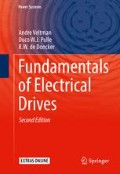Abstract
This chapter considers an extension of the (single phase) ideal transformer (ITF) model to a two-phase space vector based version. The introduction of a two- phase (ITF) model is instructive as a tool for moving towards the so-called ideal rotating transformer “IRTF” concept, which forms the basis of machine models for this book. The reader is reminded of the fact that a two-phase model is a convenient method of representing three-phase systems as discussed in Sect. 4.6 The development from ITF to a generalized two-inductance model, as discussed for the single phase model (see Chap. 3), is almost identical for the two-phase model. Consequently, it is not instructive to repeat this process here. Instead, emphasis is placed in this chapter on the development of a two-phase space vector based ITF symbolic and generic model.
Access this chapter
Tax calculation will be finalised at checkout
Purchases are for personal use only
References
Bodefeld T, Sequenz H (1971) Elektrische Maschinen, 8th edn. Springer, New York
De Doncker RW, Pulle DWJ, Veltman A (2010) Advanced electrical drives. Springer, New York
FEMM Finite Element Software (2014). http://www.femm.info
Holmes D (1997) A generalised approach to modulation and control of hard switched converters. PhD thesis, Department of Electrical and Computer Engineering, Monash University, Clayton
Hughes A, Drury B (2013) Electric motors and drives, 4th edn. Newnes, London
LaunchXL-F28069M (2015) Texas instruments: InstaSPIN-MOTION. http://www.ti.com/tool/launchxl-f28069M
Leonhard W (2001) Control of electrical drives, 3rd edn. Springer, New York
Miller TJE (1989) Brushless permanent-magnet and reluctance motor drives. Monographs in electrical and electronic engineering, vol. 21. Oxford Science Publications, Oxford
PLEXIM®; Simulation Software (2010). http://www.plexim.com
Pulle DWJ, Darnell P, Veltman A (2015) Applied control of electrical drives. Springer, New York
Schoonhoven EB (2015). http://issuu.com/eriksbv/docs/lineair-en-motion-control
Svensson T (1988) On modulation and control of electronic power converters. Tech. Rep. 186, Chalmers University of Technology, School of Electrical and Computer engineering
Veltman A (1994) The fish method: interaction between AC-machines and switching power converters. PhD thesis, Department of Electrical Engineering, Delft Technical University
VisSim®; Embedded Software (2010). http://www.vissim.com
Author information
Authors and Affiliations
6.1 Electronic Supplementary Material
Rights and permissions
Copyright information
© 2016 Springer International Publishing Switzerland
About this chapter
Cite this chapter
Veltman, A., Pulle, D.W.J., De Doncker, R.W. (2016). Space Vector Based Transformer Models. In: Fundamentals of Electrical Drives. Power Systems. Springer, Cham. https://doi.org/10.1007/978-3-319-29409-4_6
Download citation
DOI: https://doi.org/10.1007/978-3-319-29409-4_6
Published:
Publisher Name: Springer, Cham
Print ISBN: 978-3-319-29408-7
Online ISBN: 978-3-319-29409-4
eBook Packages: EnergyEnergy (R0)

